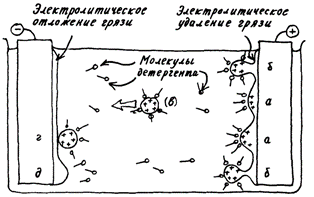Categories: Featured Articles » Controversial issues
Number of views: 15453
Comments on the article: 0
Daedalus' Inventions: Electric Cleaning
 From the point of view of chemical technology, washing dishes is a very uneconomical process: to wash off a little dirt, a huge amount of water is consumed. Washing and bathing give us even more egregious examples of wastefulness, and many industrial processes are even worse.
From the point of view of chemical technology, washing dishes is a very uneconomical process: to wash off a little dirt, a huge amount of water is consumed. Washing and bathing give us even more egregious examples of wastefulness, and many industrial processes are even worse.
Each dirt particle is enveloped in a layer of detergent molecules (detergent), which holds it in suspension in a liquid, so that this expensive product ultimately also goes into a drain pipe.
In search of austerity measures, Daedalus remembered electroplating - the method of applying metal coatings by electrolytic deposition of metal on the surface of the product. Similarly, Daedalus argues, dirt from the cleaning solution can settle on the corresponding electrode.
As the electrode becomes covered with a film of dirt, the detergent molecules will be released - so we get a clean, foamy detergent solution suitable for reuse.
On this principle, Daedalus creates “eternal” basins for washing dishes, “eternal” washing troughs and bathtubs. Dirt that enters the cleaning solution is removed by electroplating, and a single charge with washing powder and clean water will last forever!
Moreover, the deposition of dirt on one electrode may be accompanied by the opposite process - its removal from another electrode. Probably, such a silent electrolytic process will remove dirt from a spoon and a greasy shirt no worse than a hand or mechanical washing and washing.
Daedalus designs a hygienic electric bath, where the visitor (acting as one of the electrodes!) Is subjected to anode cleaning; dirt collects on another electrode located next to the drain hole.
Electrical removal of surface contamination will be the cleanest cleaning method ever available. It will leave a delightful sensation of sparkling purity, especially if you have to apply high voltage or ultrasound.
But what to do with those electrodes on which dirt is deposited? Thick, greasy, fibrous deposits stick to them no worse than any paint. Perhaps this substance should be used as a paint, fixing the coating thus obtained by hot drying?
Perhaps the idea of combining a public bath with a car body painting workshop where the product of collective washing will be used as paint should be left: the color scheme of cars will be too poor. Most likely the dirt deposited on the electrodes will have to be scraped off and sold on the mushroom plantation.
New Scientist, July 20, 1978
On the positive electrode, there is dirt to be removed. The surface tension of the film, already weakened by adsorption of the detergent molecules (a), is counteracted by the repulsive forces created by the surface positive charge; finally, positively charged dirt particles (b) leave the electrode and move in suspension (c) to the negative electrode.
At the negative electrode (g), the positive charge is neutralized. A droplet merges with a film of dirt (d); due to a decrease in the surface area, the detergent molecules are pushed out of the film and migrate to the positive electrode.
See also at bgv.electricianexp.com
:

